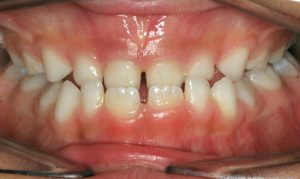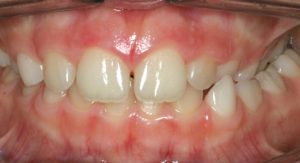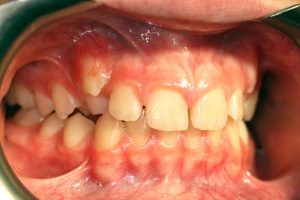• Front Crossbite
A crossbite involving the front teeth: if the lower teeth are biting in front of the upper teeth, it is a situation that demands immediate intervention. The condition will trap the upper jaw from growing forward, and as the teeth grow longer with time, it will be harder to reverse the crossbite.
• Side Crossbite
A crossbite involving the side primary molars means that the top jaw is smaller than it should be and is an indication for immediate intervention. To read more, click here…
• No Space For Lateral Incisors
Around age 8, as the baby upper lateral incisors are shed, there is very little space for the permanent laterals to erupt. These need at least 7 mm of room.
• Flared Lateral Incisors
If lateral incisors are fully erupted around age 9, and they look like they are flared sideways, this is a warning that there is impending crowding. The underlying canines, due to lack of space on their eruption path (see below) are pushing against the roots of these laterals and shifting their position.
• Displaced Canines
Around age 11 the upper canines will appear. Among all the permanent teeth, these ones travel the longest path before they emerge. They start their journey from the space right next to the nose, almost under the eye, and travel down over many years. If there is insufficient space, they will emerge “ectopically”, that is sideways, or they will be impacted within the palate.
• Overclosed Bite
When a child bites down and the lower incisors are hardly visible, that means there is an overclosed bite, a vertical discrepancy, which has serious future consequences if not treated early. To read more about this condition and how it is treated, click here…





